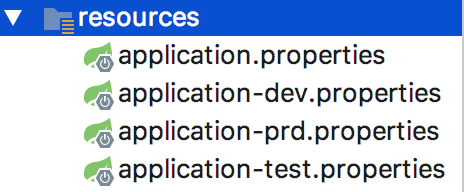假设项目需要分3个环境部署:dev、test、prd, 对于springboot的项目, 可以使用以下方式:
1, 使用springboot自己的profile
springboot的多环境配置文件名必须约定满足application-{profile}.properties的格式, 如:

然后需要设置spring.profiles.active的值,才可以激活对应的profile.
我们可以在application.properties文件中激活, 如:
spring.profiles.active=dev
也可以在运行jar包时激活, 会覆盖上面的, 如:
java -jar hello.jar --spring.profiles.active=test
或者
java -Dspring.profiles.active=test -jar hello.jar 注解@Profile介绍:
在springboot中开发java组件时,可以通过@Profile决定该类是否实例化, @Profile(“dev”)表示只有spring.profiles.active=dev时,才会去实例化当前类 .可以用在一些场景中, 比如: 在开发测试环节, 需要屏蔽掉发短信接口. 请看代码:
@Service
@Profile({"dev","test"})
public class DevTestSmsServiceImpl implements SmsService {
@Override
public void send() {
System.out.println("开发测试阶段不需要发短信");
}
}
@Service
@Profile("prd")
public class PrdSmsServiceImpl implements SmsService {
@Override
public void send() {
System.out.println("调用真实短信接口");
}
}2, 使用打包工具的profile
对于springboot的profile,有人会觉得对配置文件的路径和命名约定会带来不灵活, 也有人会觉得把所有配置文件不分环境青红皂白地都打进jar包里是不是有点粗暴?
回到传统的做法上来, 我们可以考虑使用打包工具的profile, 在打包阶段即划清各个环境的配置.
maven profile ( http://maven.apache.org/guides/introduction/introduction-to-profiles.html )
官网介绍maven profile的使用方式有很多, 这里选取比较常用的一种, 在pom文件里配置好profile, 然后在mvn 命令打包时进行激活.
pom文件, 如:
<?xml version="1.0" encoding="UTF-8"?>
<project xmlns="http://maven.apache.org/POM/4.0.0"
xmlns:xsi="http://www.w3.org/2001/XMLSchema-instance"
xsi:schemaLocation="http://maven.apache.org/POM/4.0.0 http://maven.apache.org/xsd/maven-4.0.0.xsd">
<modelVersion>4.0.0</modelVersion>
<groupId>com.wx</groupId>
<artifactId>hello</artifactId>
<version>1.0-SNAPSHOT</version>
<parent>
<groupId>org.springframework.boot</groupId>
<artifactId>spring-boot-starter-parent</artifactId>
<version>1.5.12.RELEASE</version>
</parent>
<dependencies>
<dependency>
<groupId>org.springframework.boot</groupId>
<artifactId>spring-boot-starter-web</artifactId>
</dependency>
</dependencies>
<!--定义3个profile-->
<profiles>
<profile>
<id>dev-profile</id>
<activation>
<property>
<name>maven.profile.env</name>
<value>dev</value>
</property>
<activeByDefault>true</activeByDefault>
</activation>
<properties>
<env>dev</env>
</properties>
</profile>
<profile>
<id>test-profile</id>
<activation>
<property>
<name>maven.profile.env</name>
<value>test</value>
</property>
</activation>
<properties>
<env>test</env>
</properties>
</profile>
<profile>
<id>prd-profile</id>
<activation>
<property>
<name>maven.profile.env</name>
<value>prd</value>
</property>
</activation>
<properties>
<env>prd</env>
</properties>
</profile>
</profiles>
<build>
<plugins>
<plugin>
<groupId>org.springframework.boot</groupId>
<artifactId>spring-boot-maven-plugin</artifactId>
</plugin>
</plugins>
<!--定制打包时的资源拷贝-->
<resources>
<resource>
<directory>src/main/resources</directory>
<targetPath>./</targetPath>
<includes>
<include>application.properties</include>
<include>application-${env}.properties</include>
</includes>
</resource>
</resources>
</build>
</project>然后在mvn命令中设置maven.profile.env的值, 如:
mvn clean package -Dmaven.skip.test=true -Dmaven.profile.env=prd
则最终的打进jar包里的配置文件就是这样的:
